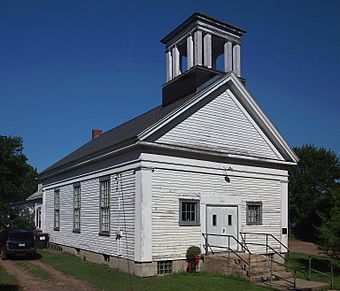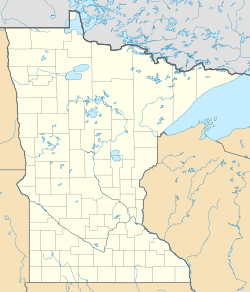First Congregational Church of Clearwater facts for kids
Quick facts for kids |
|
|
First Congregational Church of Clearwater
|
|

The First Congregational Church of Clearwater from the east
|
|
| Location | 405 Bluff Street, Clearwater, Minnesota |
|---|---|
| Area | Less than one acre |
| Built | 1861 |
| Architectural style | Greek Revival |
| MPS | Wright County MRA |
| NRHP reference No. | 79001260 |
| Added to NRHP | December 11, 1979 |
The First Congregational Church of Clearwater, also known as the Clearwater Gospel Tabernacle, is a very old church building in Clearwater, Minnesota. It was built way back in 1861. This church is special because it was added to the National Register of Historic Places in 1979. This means it's recognized as an important historical site for its unique design and its role in the early settlement of the area.
The church is known for its Greek Revival architecture, which means it looks a bit like ancient Greek temples. It also has a strong connection to the first settlers who came to the area from New England. In the early 1860s, people in Clearwater faced some scary times. Because of worries about safety, many settlers were very afraid. The church became a safe place during these times.
Contents
A Historic Building
The First Congregational Church of Clearwater was built in 1861. It was designed in the Greek Revival style. This style was popular in the United States during the 1800s. Buildings in this style often have tall columns and grand entrances, similar to ancient Greek temples. The church's design shows the architectural trends of its time.
Early Settlers and Community
The church was important to the early settlers of Clearwater. Many of these settlers came from the New England region of the United States. They brought their traditions and building styles with them. The church served as a central gathering place for the community. It was a spot for worship, meetings, and social events.
A Place of Refuge
In 1862 and 1863, there were difficult times in Minnesota. People in the Clearwater area became very worried about their safety. Some families even decided to move away permanently. The people who stayed in Clearwater chose their church as a possible safe spot. It was the biggest and strongest building they had.
Preparing for Safety
The community worked together to make the church a safe place. They built a strong fence, called a stockade, around it. They also stored food and supplies inside. This was done so people could stay there if they needed to. After several months, the worries lessened, and the church was no longer needed as a fort. This shows how important the church was to the community's survival and peace of mind during a challenging period.
See also
- List of Congregational churches
- National Register of Historic Places listings in Wright County, Minnesota



